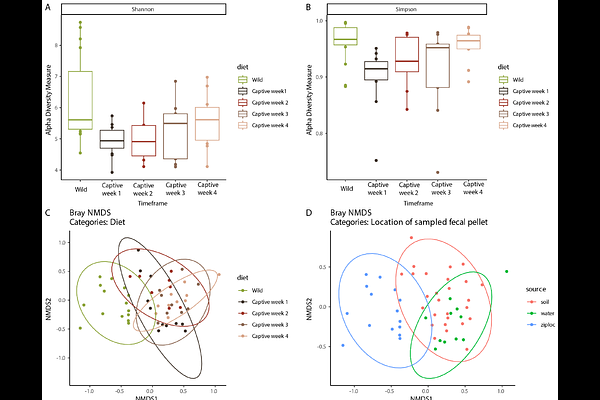Characterization of a core fungal community and captivity-induced "mycobiome" change in Fowler's Toad (Anaxyrus fowleri)

Characterization of a core fungal community and captivity-induced "mycobiome" change in Fowler's Toad (Anaxyrus fowleri)
Bradshaw, A. J.; Poo, S.; Malter, T. E.; Strasbaugh, R. M.; Bodner, B.; Hincher, M. R.; Devan-Song, A.; Tabima, J. F.
AbstractAmphibious animals, such as frogs and toads, are found at the intersection of aquatic and terrestrial ecosystems. They often serve as keystone and sentinel species, essential in nutrient cycling and food webs. In recent decades, amphibians have experienced drastic population declines due to habitat loss, climate change, and disease. These declines have prompted investments in ex situ conservation and captive breeding programs, which aim to reduce extinction risk by creating assurance colonies and reintroducing individuals once threats are mitigated. A critical component of these programs is proper husbandry, ensuring the health and longevity of captive populations and their ability to reproduce offspring that can be reintroduced into the wild. The artificial environment in captivity can profoundly impact animal behavior and health, particularly concerning diet and nutrition. Diet not only provides nutrients and energy but also shapes the host's gut microbial community, which in turn impacts digestive health. Complex microbial communities, collectively known as the microbiome, are characterized by the high biodiversity of prokaryotes, microscopic fungi, and viruses. The diet-associated microbiome is increasingly studied for its role in captive animal health and behavior, although research has focused more on bacteria than fungal communities, or the "mycobiome". Here, we investigated the core mycobiome using metabarcoding of fungal communities in fifteen Anaxyrus fowleri (Fowler's Toad) specimens, documenting shifts as toads transition from wild to captive settings. We identified a core set of fungal taxa and observed distinct changes in non-core fungi associated with dietary differences. These findings highlight the dynamic nature of the amphibian mycobiome and the significant impact captivity can have on microbial composition, providing a framework for understanding the role of the amphibian mycobiome in future conservation efforts.